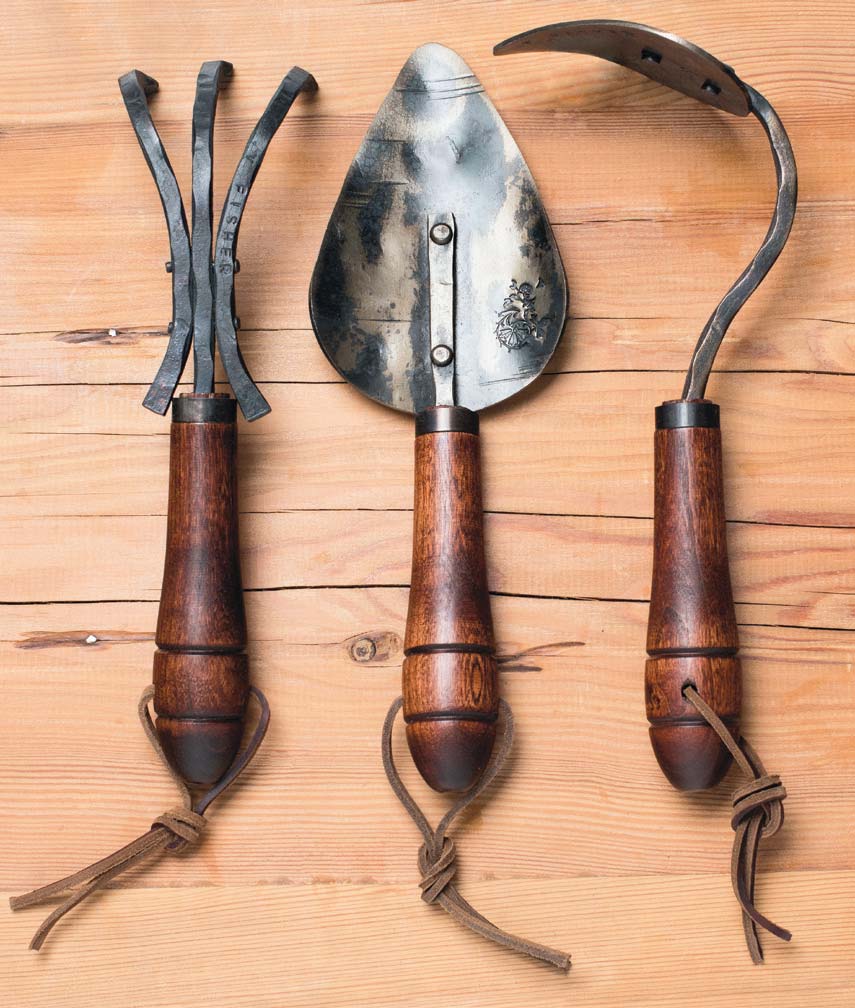Photo by Rab Cummings
The Tools of Blacksmith Tuli Fisher
Shape, function, balance, consistency: Inspect a hand-forged garden tool made by Bozeman blacksmith Tuli Fisher and you’ll notice the lavish attention he pays to each of these design principles. Indeed, every item that he crafts—from the planting trowels and dibbles to the garden rakes, hoes, and shovels—elicits comparisons to museum-quality art. Fisher’s tools merge the precision of blacksmithing and woodworking with the garden’s spirit, creating items that are eye-ravishing yet workable, intended to be used but artful enough to drape on the wall of the tool shed.
“I’m really excited about them,” Fisher says. “Overall, people are really hungry for and attracted to the personal connection between themselves, their hand tool, and the person who made the tool. They’re also attracted to the work that the tool is going to allow them to do.”
A native of Indiana, Fisher grew up living with and learning about horses on the family farm. He moved to Montana in 1999 to pursue work as a farrier and ended up graduating from MSU with degrees in history and museum studies. In 2003, he designed and built his first collection of garden tools.
Before jumping into life as a full-time blacksmith, Fisher operated a robust horseshoeing business for about a dozen years, his time shoeing horses’ hooves giving him the confidence to work with his hands and to realize a project from beginning to end. All the while, gardening tools were an ongoing journey into new territory.
Fisher’s tools merge the precision of blacksmithing and woodworking with the garden’s spirit
“Ultimately, I decided that I wanted to make a functional tool that would really help people do something positive in their life,” he says. To touch the smooth wooden grain and structural steel surface of Fisher’s hand-forged garden tools is to experience the recognizable in a whole new way. Straightforward craftsmanship of tongs and hammers has been reduced to a pair of natural materials: abrasive-resistant steel and walnut. To finish a slim trowel with a black walnut grip or a thick gardening fork comprised of solid steel rivets, Fisher employs what would be considered traditional blacksmithing techniques, meaning that he heats the steel in the forge, shapes it over the heavy anvil, then delivers a series of hard whacks to it from the hammer.

“The construction of the tools is easy to understand,” Fisher says. “And the material—steel and wood—lends itself well to garden tools. The rivets are exposed, and one can clearly see what’s holding it together. You can see and easily imagine how it was built.”
Some might see one of Fisher’s garden tools and call it beautiful but overlook its utilitarian essence; others, at first, might be more concerned with its functionality, sizing up a hand-forged perennial trowel that looks practical and whose beauty is incidental. Perhaps the warmest, most ideal reception is from someone who connects with one of Fisher’s tools on a lighter, more spirited set of terms—physically, aesthetically, or even financially—and perceives how such terms are all intertwined.
Adhering to the art of traditional blacksmithing, respectful to heed its authority, Fisher projects the aspirational drive of the doer who never looses contact with the reality that connects people to their craft. In previous times he experimented with a number of woods other than walnut, but has since realized that walnut is the friendliest of the fine grains to work with—a smooth-finishing, appealing, and dark-colored complement to his constructs. He previously fashioned tools out of other types of material, like aluminum, but has concluded that anything lighter or softer than steel just isn’t sturdy enough to last as one of his garden tools.
“That’s the first rule of toolmaking: They absolutely have to hold up,” Fisher says. He desires to produce “heirloom quality” tools—items hardy enough to withstand generations of burrowing in the dirt.
There was a time early in his career when Fisher was crafting one piece at a time, birth to finish, while simultaneously toying around with design elements, all of which added extra time to the process. These days, he crafts a dozen diff erent kinds of gardening tools in a much more effi cient manner, laboring and finishing the similarly designed pieces in small batches.
“Twenty-five trowels in a batch. 25 hoes. Making pieces for 25 rakes. The efficiency is multiplied,” he says. “Plus, larger batches would become less fun, and since there is always the chance of a mistake, I’ve limited the size of my batches. Even so, I might be producing about 3,000 total pieces this year, perhaps even 4,000.”
Though he is many years deep into his calling, Fisher speaks of its innate wonder, revealed to him not only in the forms themselves but also in the visual elements and materials that defi ne and document them. He is still thickly enamored with the forge-to-garden loop that fondly straps the business together.
“To have something with intrinsic value and to use it to create your own artwork—to create your garden—there is a lot of additional value in that,” he says. “These tools reflect the garden as art.”




